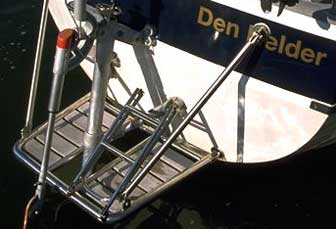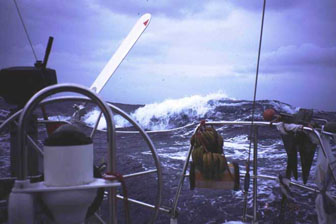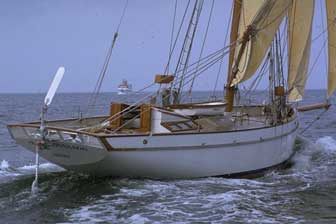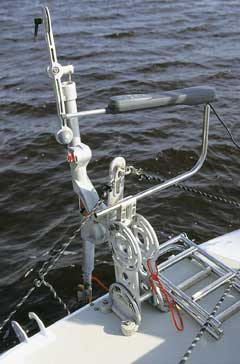|
An A to Z of tips and information
|
|
|
|
Aluminium
- Windpilot uses AlMg 5 grade alloy, which is completely resistant to seawater.
- We exhibited the Pacific system used by German yachtswomen Gudrun Calligaro for her two year solo circumnavigation at the BOOT '94 boat show in Dusseldorf. It was in such good condition that quite a few of our visitors just could not bring themselves to accept that it really had been all the way around the world!
|
|
|
Bathing platform
- Bathing platforms are ideal on a long trip, as the dinghy is the only route ashore when anchored and over the stern is the only safe way to board and leave the dinghy.
- If you've ever tried carrying fuel cans, water bottles and boxes of provisions up a shaky ladder, you'll appreciate the difference a platform can make.
- Note: the platform should be about 50 cm above the water when the boat is stationary; otherwise it will be submerged when underway.
- A Pacific Plus will be more than happy to share the transom with your bathing platform!
|
|
Bathing ladder
- A servo-pendulum system can only provide effective steering at all angles to the wind and sea if mounted on the centreline. It is therefore imperative that the ladder be mounted offset to one side.
- What use is the pendulum rudder if it lifts right out of the water on one side every time the boat heels?
- Remember to put the ladder on the starboard side, as the pendulum rudder lifts up to port when not in use.
|
|
|
 |
Bypass valve
- Attaching the steering lines from a servo-pendulum gear to the wheel of a hydraulic steering system rarely produces satisfactory results.
- This is because the slippage inherent in most hydraulic systems allows the wheel to creep relative to the rudder.
- One solution sometimes put forward is to lead the transmission lines to the emergency tiller instead, as it acts directly on the main rudder. The wheel steering system needs to be completely disconnected from the quadrant for this approach to work, as otherwise the windvane gear will have to move the hydraulic system as well (and from the wrong end at that) every time it tries to move the rudder.
- Do not even consider doing this unless the crew in the cockpit can reach the emergency tiller easily to steer by hand when necessary. Complete isolation of the hydraulic system is the only answer. A bypass valve will not do the job.
|
Ball bearings and needle bearings
- Windpilot uses neither ball nor needle bearings: they need regular maintenance and are just too intolerant of salt crystals.
- We prefer
Delrin and PTFE sliding bearings, which give smooth movement with no maintenance.
- It has been 32 years now and demand for replacement bearings is still virtually zero - case closed!
|
|
|
Downwind sailing
- Windpilot systems love downwind courses even in the lightest of airs.
- So many bluewater sailors cannot be wrong: look for the trade wind routes and there they all are racing along with the wind at their back!
|
|
Catamarans
- A servo-pendulum system can provide excellent steering for a catamaran. Two rudders pose something of a problem, but this can be overcome by, for example, separating the mechanical connection between them.
- One rudder then remains linked to the wheel and can be used for steering by hand and fine trimming and the other is controlled by the servo-pendulum gear through the emergency tiller.
- If the wind is particularly gusty, a more reliable steering signal can be obtained by removing the windvane and using a small cockpit autopilot attached to the windvane hanger to control the pendulum arm instead.
|
|
|
Heavy weather
The pendulum rudder is virtually immune to wave damage.
Heavy weather and breaking seas tend to knock the whole boat to lee, pendulum rudder and all. Any sudden lateral movement of the boat caused by wave action is easily absorbed by a servo-pendulum gear with a bevel gear linkage, because
- the transmission lines to the main rudder act as dampers
- the pendulum rudder is much smaller than the main or auxiliary rudder to which it is connected, so a sudden shock from the latter will move the pendulum rudder blade easily without damaging the arm
- the boat's movement to lee creates additional lee helm, as there is a short delay between the movement and the pendulum arm taking up its old position relative to the boat in the new wake.
The best guarantee against damage to the pendulum arm in a broach or capsize situation is plenty of scope to pivot laterally. The main rudder can swing around wildly in a broach and the pendulum rudder has no constant water resistance to keep it in place. The pendulum arm is more likely to survive such situations unharmed if it is free to swing up to either side in response to wave impacts and shocks from the main rudder. Designated points of failure in the rudder shaft are superfluous if the pendulum arm has adequate room to move.
Modern WINDPILOT servo-pendulum systems allow the pendulum arm to move through an arc of close to 270 degrees.
|
|
 |
|
|
Ketches and yawls
- Windvane steering systems can deliver excellent steering performance on ketch- or yawl-rigged yachts provided you make sure the windvane has space and an undisturbed airflow in which to work.
- This usually means keeping the mizzen stowed or, if the boom is high enough above the deck, securing it with a preventer.
- The mizzen usually contributes more weather helm than drive when sailing off the wind anyway.
|
|
Line travel (servo-pendulum systems)
- The transmission lines from a servo-pendulum system typically have a maximum travel of about 25 cm with which to pull on the tiller or wheel and keep the boat on course.
- Every millimetre lost to stretch, slack or friction impairs steering performance by reducing the amount by which the self-steering can turn the rudder.
|
|
Loads on the transom (double rudder systems)
- The mounting components have to absorb static pressures as well and must therefore be more heavily built.
|
|
Loads on the transom (servo-pendulum systems)
- How large are the loads on the mounting components holding a servo-pendulum to the transom?
- Servo-pendulum gears are hydrodynamic systems and their power comes from the kinetic energy (movement) of the boat rather than their own mass (disconnect the transmission lines from the steering and the pendulum rudder trails effortlessly behind the boat like a seagull after a trawler)
- The maximum load on the mounting therefore equals the weight of the gear plus the force applied to the tiller or wheel to steer the boat, which explains how the mounting arrangements for modern WINDPILOT servo-pendulum systems can be so reliable despite being so compact.
- The Pacific on the 25 tonne gaff cutter shown in the picture, for example, was fitted 15 years ago and has stayed firmly in place through all kinds of weather and who knows how many miles at sea!
|
|
|
|
|
 |
Materials
- Aluminium masts are manufactured from low-tech extrudable aluminium that has to be anodised or coated to protect it against the elements. Most sailors nevertheless seem happy to put their trust in an aluminium mast.
- Modern aluminium yachts use AlMg grade 4.5 alloy, a material that can withstand exposure to seawater even without special protective treatment (i.e. uncoated).
- Like Goiot and Lewmar, Windpilot prefers AlMg 5, which is 100% resistant to seawater even before we hard-anodise it. We provide a lifetime guarantee for all the materials used in Windpilot products.
|
|
|
Sail trim
- Sail trim is your job. Windvane gears steer, you trim sails. The better you stick to your end of the bargain, the better the steering will be. Not only that, of course, but better trim means faster boatspeed. Forget about trim and weather helm will start to build.
- That means more steering and bigger corrections and, for an autopilot, increased power consumption. A Windpilot system has no shortage of muscle, so it just carries on moving the rudder more and more. And every time the rudder moves, the boat slows down!
- A good windvane steering system gives you time to relax and enjoy your sailing - and time to trim your sails properly. Balance the trim and then you really will have nothing to do but relax: a totally novel experience on many boats!
|
|
Servo-pendulum gear as emergency rudder?
- Most unsatisfactory! The pendulum rudder blade is far, far too small to steer the boat in anything of a sea if the main rudder has been damaged or lost.
- Damage to the main rudder is unlikely to occur on a calm day...
|
|
Transmission lines
- The shorter the transmission lines and the smaller the number of turning blocks used, the better a servo-pendulum gear will perform.
- The transmission lines on traditional systems start on the pendulum rudder shaft well below deck level and require eight or ten blocks to reach the wheel or tiller.
- The transmission lines on the Pacific and Pacific Light start at the top of the pendulum arm close to deck level and manage fine with just two or four blocks. This is the shortest and most efficient way of linking the windvane gear to the main rudder.
|
|
Transom reinforcement
- Why is there little point in reinforcing the transom when mounting a WINDPILOT system?
- The loads exerted by the Pacific Light and Pacific are relatively low and the large washers supplied in the installation kit are perfectly adequate.
- The loads from the Pacific Plus are distributed over a widely spaced two-part mounting, so even though they are substantial, there is still no need for anything more than the large washers supplied.
|
|
Using the emergency tiller on wheel steering yachts
- Rigging the transmission lines to steer through the emergency tiller on a yacht with wheel steering is possible, but the results will be poor unless the wheel system can be completely isolated from the main rudder. Why should this be so? Because as long as the hydraulic or mechanical wheel steering system remains connected, the windvane gear will have to move it as well every time it wants to move the rudder.
- It's like trying to turn your car steering wheel by sitting in the road and tugging on the front wheels! Remember though that if the wheel is disconnected, you will have to use the emergency tiller for manual steering as well, so it had better be within easy reach of the cockpit.
|
|
Turning blocks
- The turning blocks for the transmission lines linking the vanegear to the tiller or wheel should where possible be tied to the pushpit etc. using only thin cord. This way if the system is overloaded in a sudden squall or windshift, the cord will break and prevent damage to any of the other components.
- A servo-pendulum system can easily put 200 kg through the turning blocks in such circumstances, which is more than enough to bend most stanchions.
|
|
Wheel adaptor
- A wheel adaptor should work like a disk brake.
- The drum around which the transmission lines wrap should be able to slide on the disk bolted to the wheel.
- This is the only way to provide precise and infinitely adjustable course control and it also allows the system to skid if overloaded - a useful security feature!
|
|
Windpilot and Autopilot
- Virtually everyone who comes to talk to us about buying a Windpilot already has an autopilot on board. Once both systems are installed, the Windpilot generally takes over up to 90% of the steering duties:
- with the sails set it's simply better to trust the wind.
|
|
Windpilot recommends
- All Windpilot systems are designed so that a small cockpit autopilot (Autohelm or Simrad) can be coupled to the windvane hanger when you need a compass course rather than apparent wind steering. The servo-pendulum system continues to provide the steering force as usual, so power consumption is minimal (all the autopilot has to do is move the windvane hanger). This arrangement means that even a relatively heavy yacht (up to 25 t) can steer itself on a compass course without overtaxing the batteries.
- The Windpilot/autopilot combination is particularly useful in passage making situations where the apparent wind speed is too low to give the windvane a reliable signal but following seas are keeping the boat moving fast enough for the servo system to operate effectively. This hybrid solution goes a long way towards overcoming the drawbacks of both systems. Just imagine: powerful and effective steering to a compass course without draining the batteries. Add to that the fact that buying the two systems will be much less painful financially than a high performance inboard autopilot and windvane gear and the argument should be all over.
|
|
|
|
 |
Yaw damping
- Servo-pendulum systems without yaw damping are prone to oversteering, that is they overcorrect, turn too far and then have to turn back the other way again to bring the boat back onto course. Effective yaw damping prevents oversteer.
- Any good servo-pendulum system will have yaw damping provided by a 2:1 bevel gear linkage. Aries, Monitor and Windpilot are identical in this respect.
|
|
|
|
|
|
|
|
|
|
|
|
|
|




